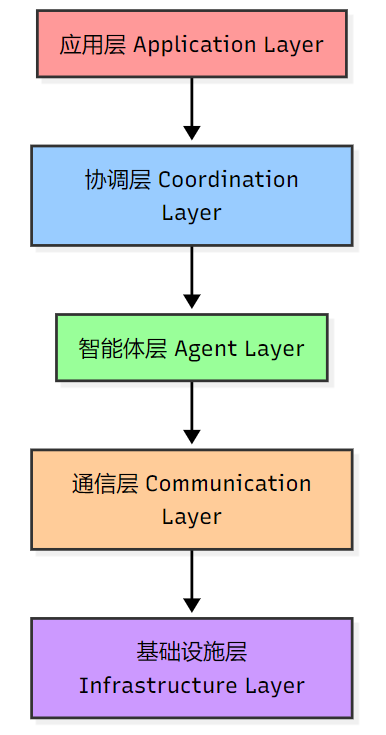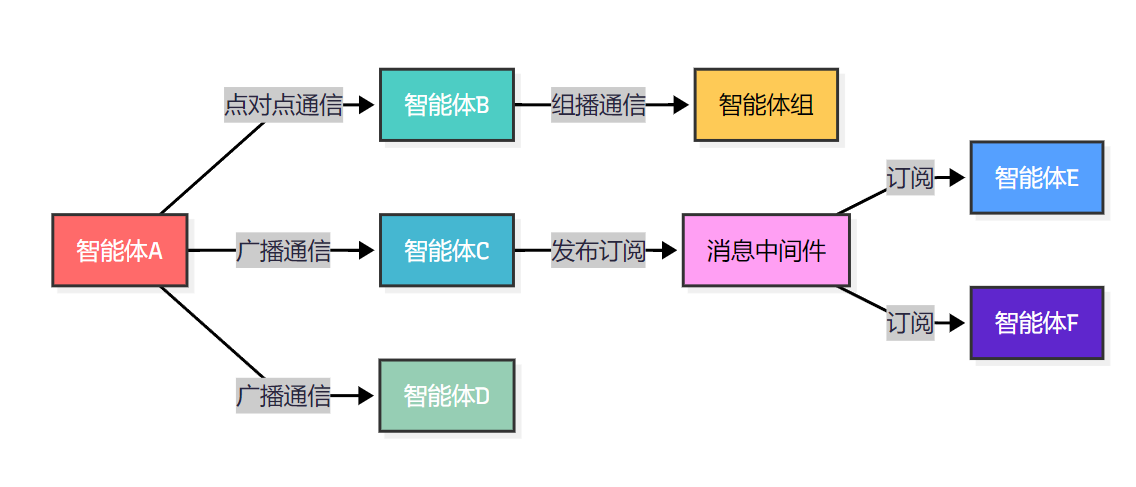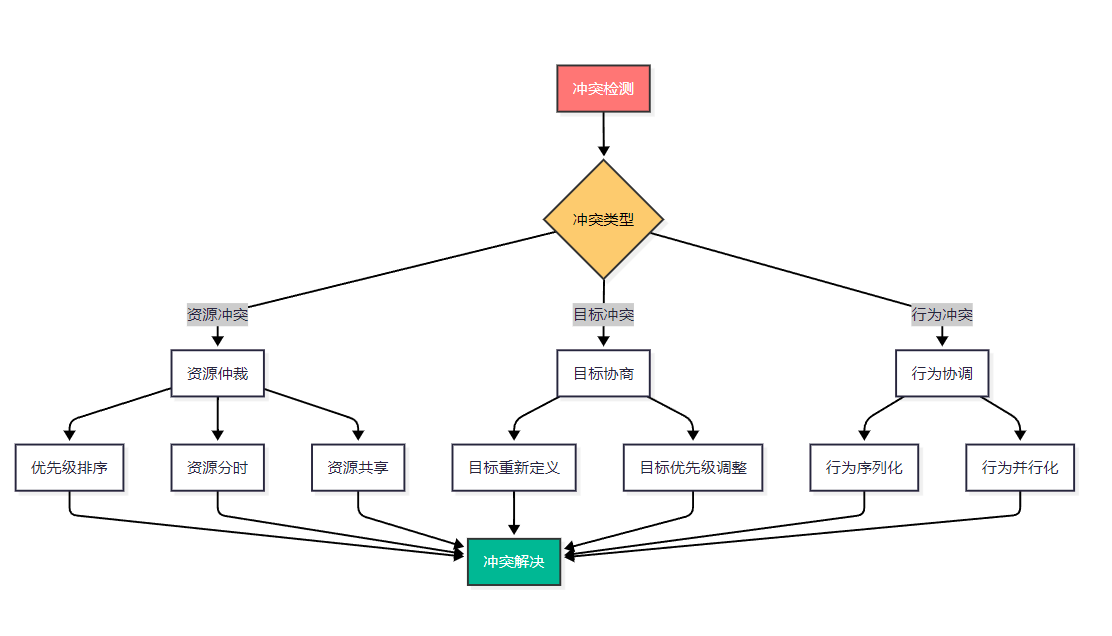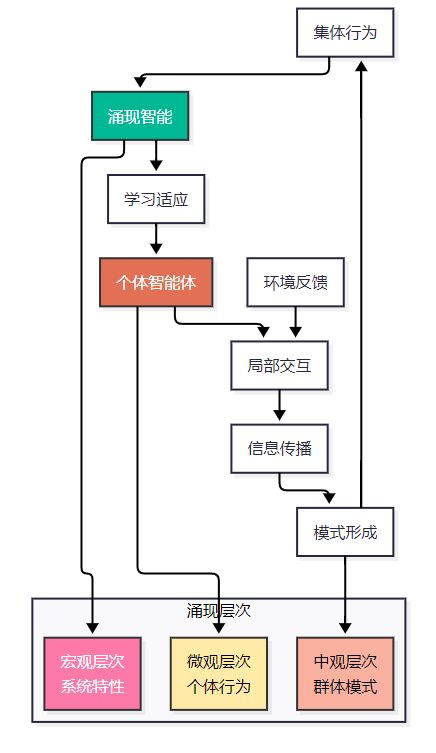多智能体系统设计:协作、竞争与涌现行为

多智能体系统设计:协作、竞争与涌现行为
🌟 Hello,我是摘星!
🌈 在彩虹般绚烂的技术栈中,我是那个永不停歇的色彩收集者。
🦋 每一个优化都是我培育的花朵,每一个特性都是我放飞的蝴蝶。
🔬 每一次代码审查都是我的显微镜观察,每一次重构都是我的化学实验。
🎵 在编程的交响乐中,我既是指挥家也是演奏者。让我们一起,在技术的音乐厅里,奏响属于程序员的华美乐章。
目录
多智能体系统设计:协作、竞争与涌现行为
摘要
1. 多智能体架构设计原则
1.1 核心设计理念
1.2 分层架构模式
1.3 架构设计对比
1.4 自主性与社会性平衡
2. 通信协议与消息传递
2.1 通信协议设计
2.2 消息传递模式
2.3 异步通信实现
2.4 通信协议性能对比
3. 冲突解决与共识机制
3.1 冲突检测机制
3.2 共识算法实现
3.3 冲突解决策略
3.4 拜占庭容错机制
4. 集体智能的涌现现象
4.1 涌现行为的理论基础
4.2 群体智能算法
4.3 涌现行为可视化
4.4 涌现行为评估指标
4.5 实际应用案例
5. 系统性能评估与优化
5.1 性能评估框架
5.2 性能优化策略
总结
参考资料
摘要
作为一名长期专注于分布式系统和人工智能领域的技术博主,我深深被多智能体系统(Multi-Agent Systems, MAS)的复杂性和优雅性所吸引。在过去几年的研究和实践中,我见证了多智能体系统从理论概念逐步走向实际应用的转变过程。多智能体系统不仅仅是简单的分布式计算模型,它更像是一个微观社会,其中每个智能体都具有自主性、反应性和社会性。这些智能体通过复杂的交互模式,展现出了令人惊叹的集体智能现象。从最初的简单协作模式,到复杂的竞争博弈,再到最终涌现出的群体智慧,多智能体系统为我们提供了一个全新的视角来理解和设计复杂系统。在本文中,我将从架构设计原则出发,深入探讨通信协议的设计要点,分析冲突解决机制的实现策略,并重点阐述集体智能涌现现象的内在机理。通过理论分析与实践案例相结合的方式,我希望能够为读者提供一个全面而深入的多智能体系统设计指南,帮助大家在这个充满挑战和机遇的领域中找到属于自己的技术路径。
1. 多智能体架构设计原则
1.1 核心设计理念
多智能体系统的架构设计需要遵循几个核心原则,这些原则确保系统的可扩展性、鲁棒性和效率。
class Agent:"""基础智能体类定义"""def __init__(self, agent_id, capabilities, goals):self.agent_id = agent_idself.capabilities = capabilities # 智能体能力集合self.goals = goals # 目标集合self.knowledge_base = {} # 知识库self.communication_module = CommunicationModule()self.decision_engine = DecisionEngine()def perceive(self, environment):"""感知环境状态"""return environment.get_state(self.agent_id)def decide(self, perception):"""基于感知信息做出决策"""return self.decision_engine.process(perception, self.goals)def act(self, action, environment):"""执行动作"""return environment.execute_action(self.agent_id, action)1.2 分层架构模式
多智能体系统通常采用分层架构来管理复杂性:

图1 多智能体系统分层架构图
1.3 架构设计对比
| 架构模式 | 优势 | 劣势 | 适用场景 |
| 集中式架构 | 控制简单,一致性强 | 单点故障,扩展性差 | 小规模系统 |
| 分布式架构 | 高可用性,可扩展 | 协调复杂,一致性难保证 | 大规模系统 |
| 混合式架构 | 平衡性能与复杂度 | 设计复杂 | 中等规模系统 |
| 层次化架构 | 职责清晰,易维护 | 通信开销大 | 复杂业务系统 |
1.4 自主性与社会性平衡
class AutonomousAgent(Agent):"""自主智能体实现"""def __init__(self, agent_id, autonomy_level=0.8):super().__init__(agent_id, [], [])self.autonomy_level = autonomy_level # 自主性程度 [0,1]self.social_connections = {} # 社会连接def make_decision(self, local_info, social_info):"""平衡自主决策与社会影响"""local_weight = self.autonomy_levelsocial_weight = 1 - self.autonomy_levellocal_decision = self.local_decision_making(local_info)social_decision = self.social_decision_making(social_info)# 加权融合决策final_decision = (local_weight * local_decision + social_weight * social_decision)return final_decision"在多智能体系统中,每个智能体都是一个独立的决策实体,但它们的行为会受到其他智能体的影响。这种自主性与社会性的平衡是系统设计的关键。" —— Stuart Russell
2. 通信协议与消息传递
2.1 通信协议设计
多智能体系统中的通信协议需要支持异步、可靠的消息传递机制:
from enum import Enum
import asyncio
import jsonclass MessageType(Enum):"""消息类型枚举"""REQUEST = "request"RESPONSE = "response"BROADCAST = "broadcast"NEGOTIATION = "negotiation"COORDINATION = "coordination"class Message:"""消息类定义"""def __init__(self, sender_id, receiver_id, msg_type, content, priority=1):self.sender_id = sender_idself.receiver_id = receiver_idself.msg_type = msg_typeself.content = contentself.priority = priorityself.timestamp = time.time()self.message_id = self.generate_id()def to_json(self):"""序列化为JSON格式"""return json.dumps({'sender_id': self.sender_id,'receiver_id': self.receiver_id,'msg_type': self.msg_type.value,'content': self.content,'priority': self.priority,'timestamp': self.timestamp,'message_id': self.message_id})2.2 消息传递模式

图2 多智能体通信模式图
2.3 异步通信实现
class CommunicationManager:"""通信管理器"""def __init__(self):self.message_queue = asyncio.Queue()self.subscribers = {} # 订阅者字典self.message_handlers = {}async def send_message(self, message):"""发送消息"""await self.message_queue.put(message)async def broadcast_message(self, sender_id, content, msg_type):"""广播消息"""for agent_id in self.subscribers.keys():if agent_id != sender_id:message = Message(sender_id, agent_id, msg_type, content)await self.send_message(message)async def process_messages(self):"""处理消息队列"""while True:try:message = await asyncio.wait_for(self.message_queue.get(), timeout=1.0)await self.handle_message(message)except asyncio.TimeoutError:continueasync def handle_message(self, message):"""处理单个消息"""handler = self.message_handlers.get(message.receiver_id)if handler:await handler(message)2.4 通信协议性能对比
| 协议类型 | 延迟 | 吞吐量 | 可靠性 | 复杂度 | 适用场景 |
| 同步通信 | 低 | 中 | 高 | 低 | 实时系统 |
| 异步通信 | 中 | 高 | 中 | 中 | 高并发系统 |
| 消息队列 | 中 | 高 | 高 | 高 | 分布式系统 |
| 发布订阅 | 高 | 很高 | 中 | 高 | 事件驱动系统 |
3. 冲突解决与共识机制
3.1 冲突检测机制
在多智能体系统中,冲突是不可避免的。有效的冲突检测是解决冲突的前提:
class ConflictDetector:"""冲突检测器"""def __init__(self):self.resource_allocation = {} # 资源分配表self.goal_conflicts = {} # 目标冲突记录def detect_resource_conflict(self, agent_requests):"""检测资源冲突"""conflicts = []resource_map = {}for agent_id, resources in agent_requests.items():for resource in resources:if resource in resource_map:# 发现冲突conflicts.append({'type': 'resource_conflict','resource': resource,'agents': [resource_map[resource], agent_id]})else:resource_map[resource] = agent_idreturn conflictsdef detect_goal_conflict(self, agent_goals):"""检测目标冲突"""conflicts = []for i, (agent1, goals1) in enumerate(agent_goals.items()):for j, (agent2, goals2) in enumerate(agent_goals.items()):if i < j: # 避免重复检测conflict_score = self.calculate_goal_conflict(goals1, goals2)if conflict_score > 0.5: # 冲突阈值conflicts.append({'type': 'goal_conflict','agents': [agent1, agent2],'score': conflict_score})return conflicts3.2 共识算法实现
class ConsensusManager:"""共识管理器"""def __init__(self, agents):self.agents = agentsself.consensus_threshold = 0.67 # 共识阈值async def reach_consensus(self, proposal):"""达成共识"""votes = await self.collect_votes(proposal)return self.evaluate_consensus(votes)async def collect_votes(self, proposal):"""收集投票"""votes = {}tasks = []for agent in self.agents:task = asyncio.create_task(agent.vote(proposal))tasks.append((agent.agent_id, task))for agent_id, task in tasks:try:vote = await asyncio.wait_for(task, timeout=5.0)votes[agent_id] = voteexcept asyncio.TimeoutError:votes[agent_id] = 'abstain' # 超时视为弃权return votesdef evaluate_consensus(self, votes):"""评估共识结果"""total_votes = len(votes)agree_votes = sum(1 for vote in votes.values() if vote == 'agree')consensus_ratio = agree_votes / total_votesreturn {'reached': consensus_ratio >= self.consensus_threshold,'ratio': consensus_ratio,'votes': votes}3.3 冲突解决策略

图3 冲突解决流程图
3.4 拜占庭容错机制
class ByzantineFaultTolerantConsensus:"""拜占庭容错共识"""def __init__(self, agents, fault_tolerance=1):self.agents = agentsself.fault_tolerance = fault_toleranceself.min_agents = 3 * fault_tolerance + 1async def pbft_consensus(self, proposal):"""实用拜占庭容错算法"""if len(self.agents) < self.min_agents:raise ValueError("智能体数量不足以支持拜占庭容错")# 阶段1:预准备pre_prepare_votes = await self.pre_prepare_phase(proposal)# 阶段2:准备prepare_votes = await self.prepare_phase(proposal, pre_prepare_votes)# 阶段3:提交commit_votes = await self.commit_phase(proposal, prepare_votes)return self.evaluate_pbft_result(commit_votes)async def pre_prepare_phase(self, proposal):"""预准备阶段"""# 主节点广播预准备消息primary = self.select_primary()return await primary.broadcast_pre_prepare(proposal)4. 集体智能的涌现现象
4.1 涌现行为的理论基础
集体智能的涌现是多智能体系统最令人着迷的现象之一。它展示了简单个体如何通过交互产生复杂的群体行为:
class EmergentBehaviorAnalyzer:"""涌现行为分析器"""def __init__(self):self.behavior_patterns = {}self.complexity_metrics = {}def analyze_emergence(self, agent_states, time_series):"""分析涌现现象"""# 计算系统复杂度system_complexity = self.calculate_system_complexity(agent_states)# 检测模式形成patterns = self.detect_patterns(time_series)# 评估涌现强度emergence_strength = self.measure_emergence_strength(agent_states, patterns)return {'complexity': system_complexity,'patterns': patterns,'emergence_strength': emergence_strength}def calculate_system_complexity(self, agent_states):"""计算系统复杂度"""# 使用信息熵衡量复杂度import numpy as npfrom scipy.stats import entropystate_distribution = self.get_state_distribution(agent_states)return entropy(state_distribution)def detect_patterns(self, time_series):"""检测行为模式"""patterns = []# 使用滑动窗口检测周期性模式window_size = 10for i in range(len(time_series) - window_size):window = time_series[i:i+window_size]pattern_strength = self.calculate_pattern_strength(window)if pattern_strength > 0.8: # 模式阈值patterns.append({'start_time': i,'pattern': window,'strength': pattern_strength})return patterns4.2 群体智能算法
class SwarmIntelligence:"""群体智能算法实现"""def __init__(self, swarm_size=50):self.swarm_size = swarm_sizeself.particles = []self.global_best = Nonedef particle_swarm_optimization(self, objective_function, dimensions):"""粒子群优化算法"""# 初始化粒子群self.initialize_swarm(dimensions)for iteration in range(1000): # 最大迭代次数for particle in self.particles:# 更新粒子位置和速度self.update_particle(particle, objective_function)# 更新全局最优解self.update_global_best(objective_function)# 检查收敛条件if self.check_convergence():breakreturn self.global_bestdef ant_colony_optimization(self, graph, start, end):"""蚁群优化算法"""pheromone_matrix = self.initialize_pheromone(graph)best_path = Nonebest_distance = float('inf')for iteration in range(100):paths = []# 每只蚂蚁寻找路径for ant in range(self.swarm_size):path = self.find_path(graph, pheromone_matrix, start, end)paths.append(path)# 更新最优路径distance = self.calculate_path_distance(path, graph)if distance < best_distance:best_distance = distancebest_path = path# 更新信息素self.update_pheromone(pheromone_matrix, paths, graph)return best_path, best_distance4.3 涌现行为可视化

图4 集体智能涌现机制图
4.4 涌现行为评估指标
| 评估维度 | 指标名称 | 计算方法 | 正常范围 | 说明 |
| 复杂度 | 信息熵 | H = -Σp(x)log(p(x)) | 0-10 | 系统状态分布的不确定性 |
| 协调性 | 同步指数 | S = 1/N Σcos(θᵢ-θⱼ) | 0-1 | 智能体行为的同步程度 |
| 适应性 | 学习率 | L = Δperformance/Δtime | 0-1 | 系统性能改进速度 |
| 鲁棒性 | 容错能力 | R = 1 - failure_rate | 0-1 | 系统对故障的抵抗能力 |
| 效率 | 资源利用率 | E = used_resources/total_resources | 0-1 | 资源使用效率 |
4.5 实际应用案例
class TrafficOptimizationSystem:"""交通优化系统案例"""def __init__(self, intersection_count):self.intersections = [TrafficLight(i) for i in range(intersection_count)]self.vehicles = []self.optimization_algorithm = SwarmIntelligence()def optimize_traffic_flow(self):"""优化交通流量"""# 收集交通数据traffic_data = self.collect_traffic_data()# 使用群体智能优化信号灯时序optimal_timing = self.optimization_algorithm.particle_swarm_optimization(self.traffic_flow_objective, len(self.intersections))# 应用优化结果self.apply_timing_optimization(optimal_timing)return self.evaluate_performance()def traffic_flow_objective(self, timing_parameters):"""交通流量目标函数"""# 模拟交通流量total_wait_time = 0total_throughput = 0for i, intersection in enumerate(self.intersections):intersection.set_timing(timing_parameters[i])wait_time, throughput = intersection.simulate_traffic()total_wait_time += wait_timetotal_throughput += throughput# 目标:最小化等待时间,最大化通行量return total_wait_time / total_throughput"涌现是复杂系统的核心特征,它告诉我们整体可以大于部分之和。在多智能体系统中,这种现象尤为明显。" —— John Holland
5. 系统性能评估与优化
5.1 性能评估框架
class PerformanceEvaluator:"""性能评估器"""def __init__(self):self.metrics = {'response_time': [],'throughput': [],'accuracy': [],'resource_utilization': [],'scalability': []}def comprehensive_evaluation(self, system, test_scenarios):"""综合性能评估"""results = {}for scenario in test_scenarios:scenario_results = self.evaluate_scenario(system, scenario)results[scenario.name] = scenario_results# 计算综合评分overall_score = self.calculate_overall_score(results)return {'detailed_results': results,'overall_score': overall_score,'recommendations': self.generate_recommendations(results)}def evaluate_scenario(self, system, scenario):"""评估单个场景"""start_time = time.time()# 执行测试场景system_response = system.execute_scenario(scenario)end_time = time.time()response_time = end_time - start_time# 计算各项指标accuracy = self.calculate_accuracy(scenario.expected, system_response)throughput = scenario.request_count / response_timeresource_usage = system.get_resource_usage()return {'response_time': response_time,'accuracy': accuracy,'throughput': throughput,'resource_usage': resource_usage}5.2 性能优化策略

图5 性能优化策略分布图
总结
经过深入的理论分析和实践探索,我对多智能体系统设计有了更加全面和深刻的认识。多智能体系统不仅是一个技术概念,更是一种全新的思维方式,它教会我们如何在复杂性中寻找秩序,在混沌中发现规律。从架构设计的基本原则到通信协议的精妙设计,从冲突解决的智慧策略到集体智能的神奇涌现,每一个环节都体现了系统工程的艺术性和科学性。在实际项目中,我深刻体会到多智能体系统设计的挑战性:如何平衡个体自主性与集体协调性,如何在保证系统性能的同时维持良好的可扩展性,如何在复杂的交互中实现有效的冲突解决机制。这些问题没有标准答案,需要我们根据具体应用场景进行权衡和优化。同时,我也看到了多智能体系统巨大的应用潜力:从智能交通系统到分布式计算,从金融风险管理到社交网络分析,多智能体系统正在改变我们解决复杂问题的方式。未来,随着人工智能技术的不断发展,多智能体系统必将在更多领域发挥重要作用。作为技术从业者,我们需要持续学习和实践,不断提升自己的系统设计能力,为构建更加智能、高效、可靠的多智能体系统贡献自己的力量。
参考资料
- Multi-Agent Systems: Algorithmic, Game-Theoretic, and Logical Foundations
- Distributed Artificial Intelligence
- FIPA Agent Communication Language Specifications
- Consensus Algorithms in Distributed Systems
- Swarm Intelligence: From Natural to Artificial Systems
🌈 我是摘星!如果这篇文章在你的技术成长路上留下了印记:
👁️ 【关注】与我一起探索技术的无限可能,见证每一次突破
👍 【点赞】为优质技术内容点亮明灯,传递知识的力量
🔖 【收藏】将精华内容珍藏,随时回顾技术要点
💬 【评论】分享你的独特见解,让思维碰撞出智慧火花
🗳️ 【投票】用你的选择为技术社区贡献一份力量
技术路漫漫,让我们携手前行,在代码的世界里摘取属于程序员的那片星辰大海!
